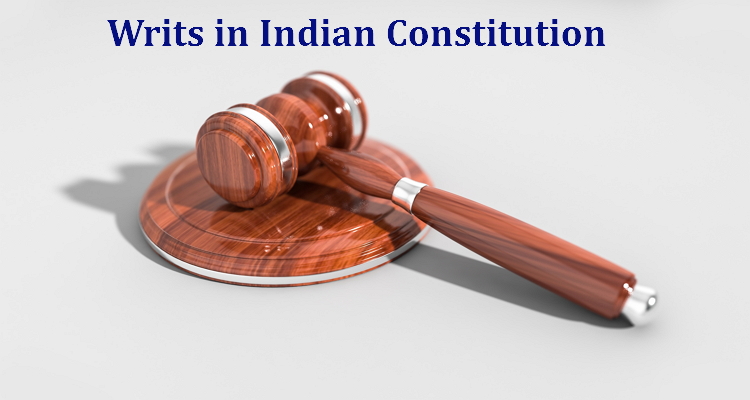What is a Writ?
A writ, in general sense means an order. In other words, a writ is a formal written order issued by a body with administrative or judicial jurisdiction. A writ is anything that is issued under an authority. Examples of writs are orders, warrants, directions etc. issued under authority. It can also be understood as; any written order having a legal backing is a writ. Thus, power to issue writs is principally a provision made, to make the Right to Constitutional Remedies available to every citizen.
Who can issue a Writ?
The Indian constitution empowers the apex court that is the Supreme Court of India and the High Courts to issue writs. Thus, writs can also be said as the order from the superior courts to lower courts, authorities or organizations. Article 32 and 226 of the Indian Constitution; deal with the concept of writs.
The Supreme Court of India, which is the apex court, is vested powers under Article 32 of the Constitution of India, to issue writs of different types to enforce the Fundamental Rights which are enshrined in PART III of the Indian Constitution. On the other hand, Article 226 empowers the High Courts to issue writs. Article 226 of the Constitution on India confers the powers of issuing writs on the High Court in case of infringement or violation of fundamental rights of the people.
In fact, the power of the High Court in issuing writs is much vast than the power enjoyed by the Supreme Court, under Article 32 of the Indian Constitution because, the High Court has the power to issue writs for the purposes, other than the enforcement of fundamental rights also. However, Parliament by law can extend power to issue writs to any other courts (including local courts) for local limits of the jurisdiction of such court.
What is a writ petition?

A writ petition is a filing that a party makes with an appeals court in order to secure a speedy review of some issue. A writ petition is a petition for extraordinary review, asking a court to intervene in a lower court’s decision. A writ means an order. A warrant is also a type of writ.
When can a writ petition be filed?
Basically, a person whose fundamental rights have been injured can file a writ petition. The aggrieved person has a choice of remedies. He may move either the Supreme Court under Article 32 or an appropriate High Court under Article 226. He will have to move the High Court which is having jurisdiction if, his grievance is that a right other than a fundamental right is violated.
An appeal can be made to the Supreme Court against the decision of the High Court. After being unsuccessful in the High Court, he cannot approach the Supreme Court under Article 32 for the same cause of action because as said earlier, such a petition would be barred by res judicata (a matter that has been already adjudged or decided).
Similarly, having failed in the Supreme Court in a petition filed under Article 32, he cannot take another chance by filing a petition under Article 226 in the High Court, over his matter because that petition would also be barred by res judicata.
Kinds of writs
Originally under the English Laws a prerogative writ which was a writ directing the behavior of another arm of government, such as an agency, official, or other court, was available only to the Crown, and reflected the discretionary prerogative and extraordinary power of the monarch. Following six writs were traditionally classified as prerogative writ: Certiorari, Habeas corpus, Mandamus, Prohibition, Procedendo, Quo warranto, also, scire facias, one of the extraordinary writs, was once known as a prerogative writ.
Writs under the Indian Constitution:
The constitution of India identifies the following “five kinds of writs”:
- Habeas corpus
- Prohibition
- Certiorari
- Mandamus
- Quo warranto
Habeas Corpus
Basically, the writ of “Habeas Corpus” is used by the courts to check whether the detention of a person is mala-fide or not. It means that, a person has been confined with a wrong intention or without jurisdiction. If the detention of the body is found to be illegal the court may order for its release. If the detention of a person illegal he himself, a friend or even a relative can file a writ of Habeas Corpus. Habeas Corpus, in Latin stands for ‘Let us have the body’ or “you may have the body.” The writ is issued to produce a person, who has been detained, whether in prison or in private custody, before a court and to release him if such detention is found illegal.
It is thus, a command addressed to a person, who is alleged to have another person unlawfully in his custody, requiring such person to whom the command is addressed, to produce or bring the body of such person before the Court.
Who can file the writ of Habeas Corpus?
According to the general rule the writ of Habeas corpus can be filed by the person whose rights have been infringed. But, there is always an exception. It states that the person himself or his friend or relative can file the petition.
To whom it is issued?
Authorities of states, Governments, Organizations or Individuals.
The writ can be issued in the following instances:
- When the person has been confined and not produced before the magistrate within 24 hours.
- When the person has not violated any law and is still arrested.
- When the reason of arrest of a person under a law is unconstitutional.
- When detention is done to harm the person or is mala-fide.
Prohibition
Typically prohibition means to stop. This writ is popularly known as a “Stay order.” The Supreme Court and High Courts may prohibit the lower courts like that of the special tribunals, magistrates, commissions or other judiciary officers who are doing an act which exceeds to their jurisdiction or acting in contrary to the rule of natural justice. E.g., if a judicial officer has personal interest in a case, it may hamper the decision and the course of natural justice.
It means that, this writ is issued when the courts have acted in excess of jurisdiction or in violation of principles of natural justice. When the writ is issued, proceedings in the lower court have stayed i.e. Res sub judice.
Who can file the writ of Prohibition?
The writ of prohibition can only be filed by the aggrieved individual.
To whom it is issued?
An Inferior Court, Tribunal, Quasi-judicial Authority.
The writ cannot be filed in the following circumstances:
- If the proceeding has matured into decision, writ will not lie.
- If the said court or authority in which writ is pending ceases to exist, writ will not lie.
Requisites of Prohibition:
- The case must be an on-going in an Inferior Court, tribunal or Quasi-judicial Authority;
- Writ of prohibition can be issued only when the proceedings are pending in a court;
- Writ of prohibition can be issued at any stage of the proceeding.
Certiorari
Certiorari means “to certify.” Writ of Certiorari is a curative writ. The writ of certiorari is issued by the High Court to subordinate judicial or quasi-judicial bodies, directing them to transfer the records of a particular case, in order to determine whether the court has the jurisdiction to give the order, or whether it is against the principles of natural justice. A writ of certiorari is corrective in nature.
When can a writ of certiorari be issued?
Writ of certiorari can be applied in situations where a court, on passing an order, has gone beyond their jurisdiction in doing so, fraud or error on the face of records. E.g., when the court passes an order for a case which they had no power to do so, the aggrieved can apply for the writ of certiorari.
Circumstances in which writ of certiorari can be issued:
1. The court, tribunal or an officer should be having legal authority to determine the question with a duty to act judicially.
2. The order passed by the court, tribunal or officer must be without jurisdiction or in excess of the judicial authority vested by law in such court, tribunal or officer.
3. The order could also be against the principles of natural justice or the order could contain an error of judgment in appreciating the facts of the case.
Against who is it issued?
It is issued against the judicial or quasi-judicial authority, acting in a judicial manner.
The difference between certiorari and prohibition is:
- The writ of certiorari will be issued when a case has been already adjudicated upon, i.e. when the decision has been announced. (Res Sub Judicata)
- Prohibition is issued during the pendency of the proceedings. (Res sub judice).
Mandamus
The term “Mandamus” means, “We Command” and this writ is issued to a person who is required under the law to perform a specify duty. In other words, the “writ of Mandamus” compels the authority to perform that duty which such authority is required to perform under the law.
Writ of Mandamus can be issued against following:
- a private individual or private body;
- if the duty in question is discretionary and not mandatory;
- against president or governors of state;
- against a working chief justice;
- To enforce some kind of private contract.
Who can file the writ of Mandamus?
A petition for writ of mandamus can be filed by any person who seeks a legal duty to be performed by a person or a body. Such a filing person must have real or special interest in the subject matter and must have legal right to do so.
What are the grounds of refusal?
When a writ of mandamus is filed the relief granted is discretionary and not a matter of right. The Court on any of the following grounds may refuse it; the Supreme Court has held that where the act against which mandamus is sought has been completed, the writ if issued, will be in fructuous. The Court would also refuse a writ of mandamus, if it would be meaningless, owing to lapse or otherwise.
Difference between Mandamus and Prohibition
- While Mandamus directs activity, Prohibition directs inactivity.
- While Mandamus can be issued against any public official, public body, corporation, inferior court, tribunal or government; prohibition can be issued only against judicial and quasi-judicial authorities and NOT against administrative authorities, legislative bodies
Quo Warranto
It means “by what authority?” or “show the authority”. The object of this writ is to prevent a person who has wrongfully and unlawfully taken the possession of the office from continuing in the office. This writ is issued to examine the legality of the claim of a person or public office. The person or authority is stopped to act in an office which he is not entitled to; and thus stops usurpation of public office by anyone.
The writ of Quo Warranto is in the nature of judicial remedy by which, any person who has occupied the office unlawfully or illegally is asked to show by what authority he holds such office. The writ of Quo warranto is pertinent only to the public offices only and not to private offices.
Essentials
- The office must have been constituted by statute, or by the Constitution itself;
- The duties of the office must be of public nature;
- The office must be one of the tenure of which is permanent in the sense of not being terminable at pleasure; and
- The person proceeded against has been in actual possession and in the user of particular office in question.



